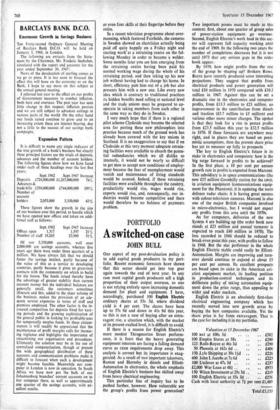A switched-on case
PORTFOLIO JOHN BULL
One aspect of my post-devaluation policy is to add capital goods producers to my port- folio. Recent economic forecasts have shown that this sector should get into top gear again towards the end of next year. In any case most capital goods producers sell a high proportion of their output overseas, so one is not relying entirely upon increasing domestic demand for plant and equipment. I have, accordingly, purchased 100 English Electric ordinary shares at 55s 3d, where dividend yield is 4 per cent. The shares have been up to 57s 9d and down to 41s 9d this year, so this is not a case of buying after an extra- vagant rise, a situation which, with the market at its present exalted level, it is difficult to avoid.
If there is a reason for English Electric's more modest Throgmorton Street perform- ance, it is fears that the heavy generating equipment interests are facing a falling demand curve as CEGB requirements drop away. This analysis is correct but its importance is exag- gerated. As a result of two important takeovers, Ruston and Hornsby in diesels and Elliott- Automation in electronics, the whole emphasis of English Electric's business has shifted away from heavy electrical engineering.
This particular line of inquiry has to be pushed further, however. How vulnerable are the group's profits from power generation?
Two important points must bz made in this context: first, about one quarter of group sales of power-station equipment go overseas. Second, English Electric's work load in this sec- tor will represent full capacity working until the end of 1969. In the following two years the number of completions decreases but it is not until 1973 that any serious gaps in the order book appear.
By 1970, how might profits from the rest of the group be shaping up? Brokers Rowe, Reeve have recently produced some interesting projections. They suggest that profits from electrical products and power generation will total £10 million in 1970 compared with £10.2 million in 1967. Against this can be set a dramatic rise in the electronics and computer profits, from £13.3 million to £23 million, an improvement in the contribution from diesels and traction (£3.7 million to £5 million) and various other more minor changes. The upshot is that they look for a rise in pretax profits from £23.5 million this year to £32.5 million in 1970. If these forecasts are anywhere near right, and in places they are based on pessi- mistic assumptions, then the present share price has yet to measure up fully to prospects.
The key to English Electric's future is its stake in electronics and computers: how is the big surge forward in profits to be achieved? In the first place, a 10 per cent per annum growth rate in profits is expected from Marconi. This subsidiary is in space communications (the new £15 million Goonhilly station for the GPo); in aviation equipment (communications equip- ment for the Phantom); it is updating the NATO defence radar chain; it is having great success with colour-television cameras. Marconi is also one of the major British companies involved in micro-electronics, but I would not expect any profits from this area until the 1970s.
As for computers, deliveries of the new System 4 are building up (the order book now stands at £23 million and annual turnover is expected to reach £40 million in 1970). The loss recorded in 1966 should be reduced to break-even point this year, with profits to follow in 1968. But the star performer in the whole English Electric stable could easily be Elliott- Automation. Margins are improving and turn- over should continue to expand at about 15 per cent per annum. Its excellent prospects are based upon its stake in the American avi- ation equipment market, its leading position in production-control techniques and its deliberate policy of taking automation equip- ment down the price range, thus appealing to wider and wider markets.
English Electric is an absolutely first-class electrical engineering company which has recently moved into new growth areas by buying the best companies available. Yet the share price is far from extravagant. That is the case for including it in my portfolio.
Valuation at 13 December 1967 100 BAT at 100s 3d
••
£502 100 Empire Stores at 58s
••
£290 125 Rolls-Royce at 46s 3d
••
£290 50 Phoenix at 162s 6d ..
••
£406 150 Lyle Shipping at 30s lid • •
••
£226 600 John I. Jacobs at 7s 6d . .
••
£225 100 Unilever at 47s 3d .. . .
••
£237 £2,000 War Loan at 481 .
••
£975 150 Witan Investment at 29s 3d ..
••
£219 100 English Electric at 55s 3d
£276 Cash with local authority at 71 per cent £1,489 Total £5,135


































 Previous page
Previous page